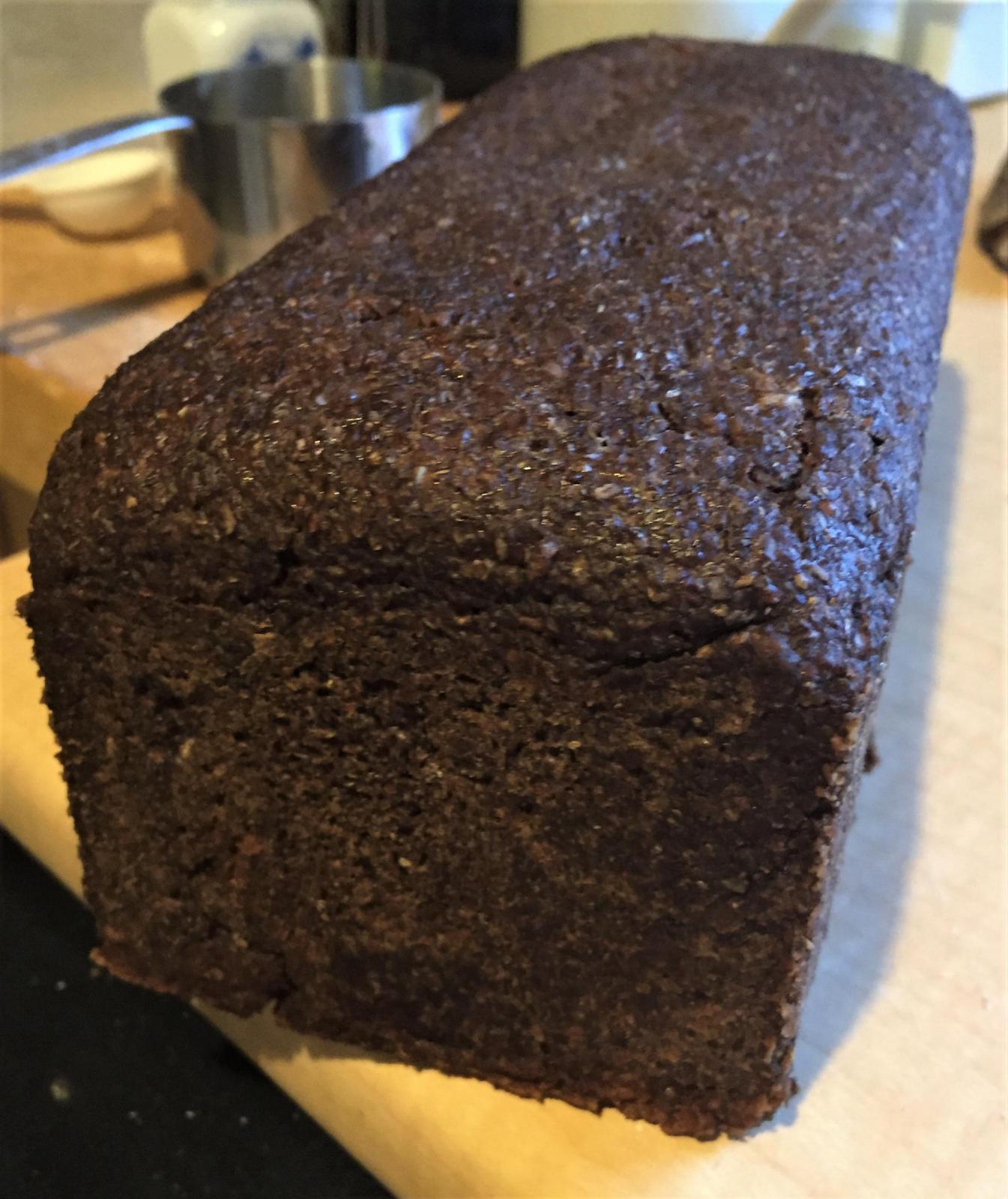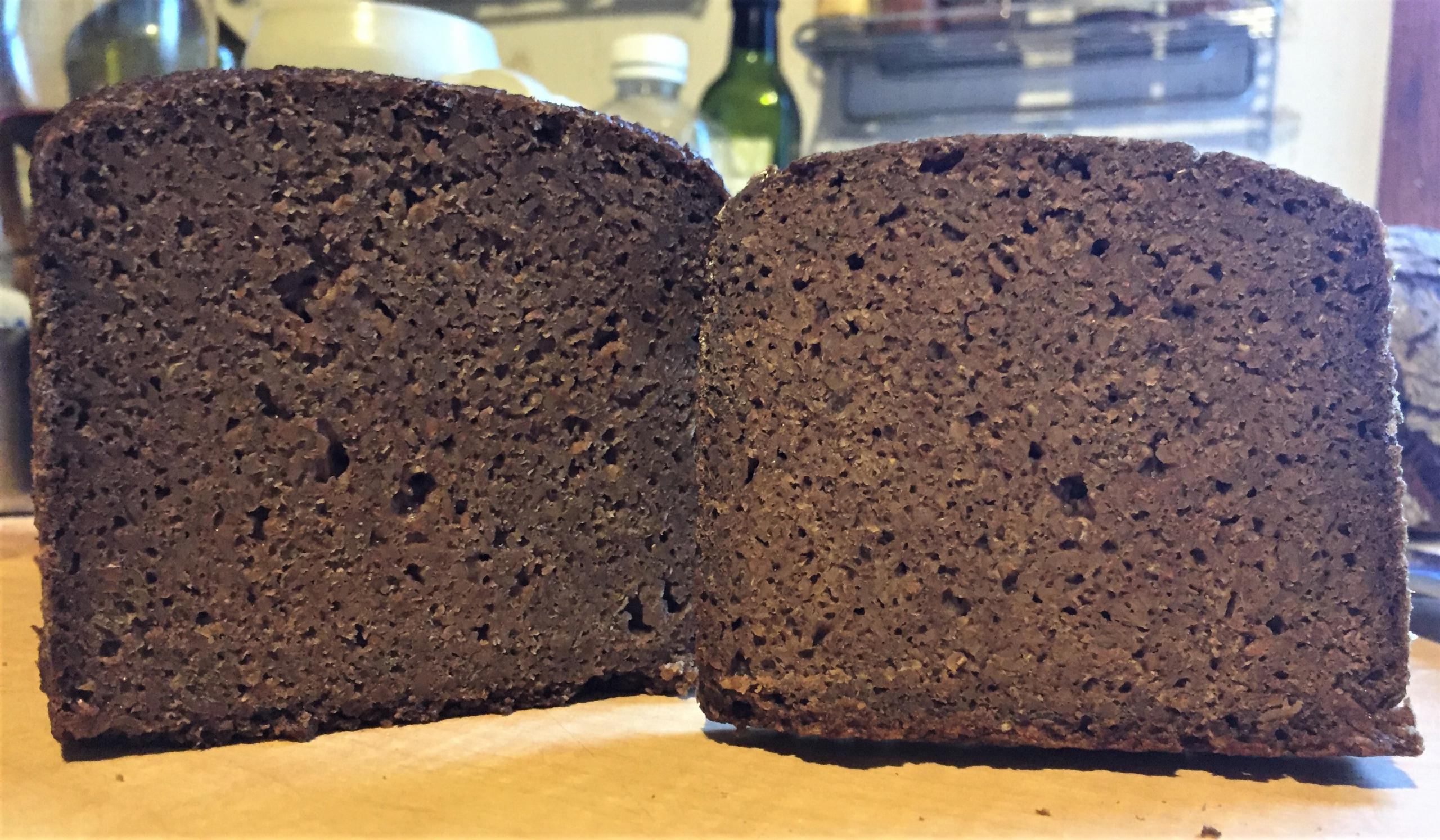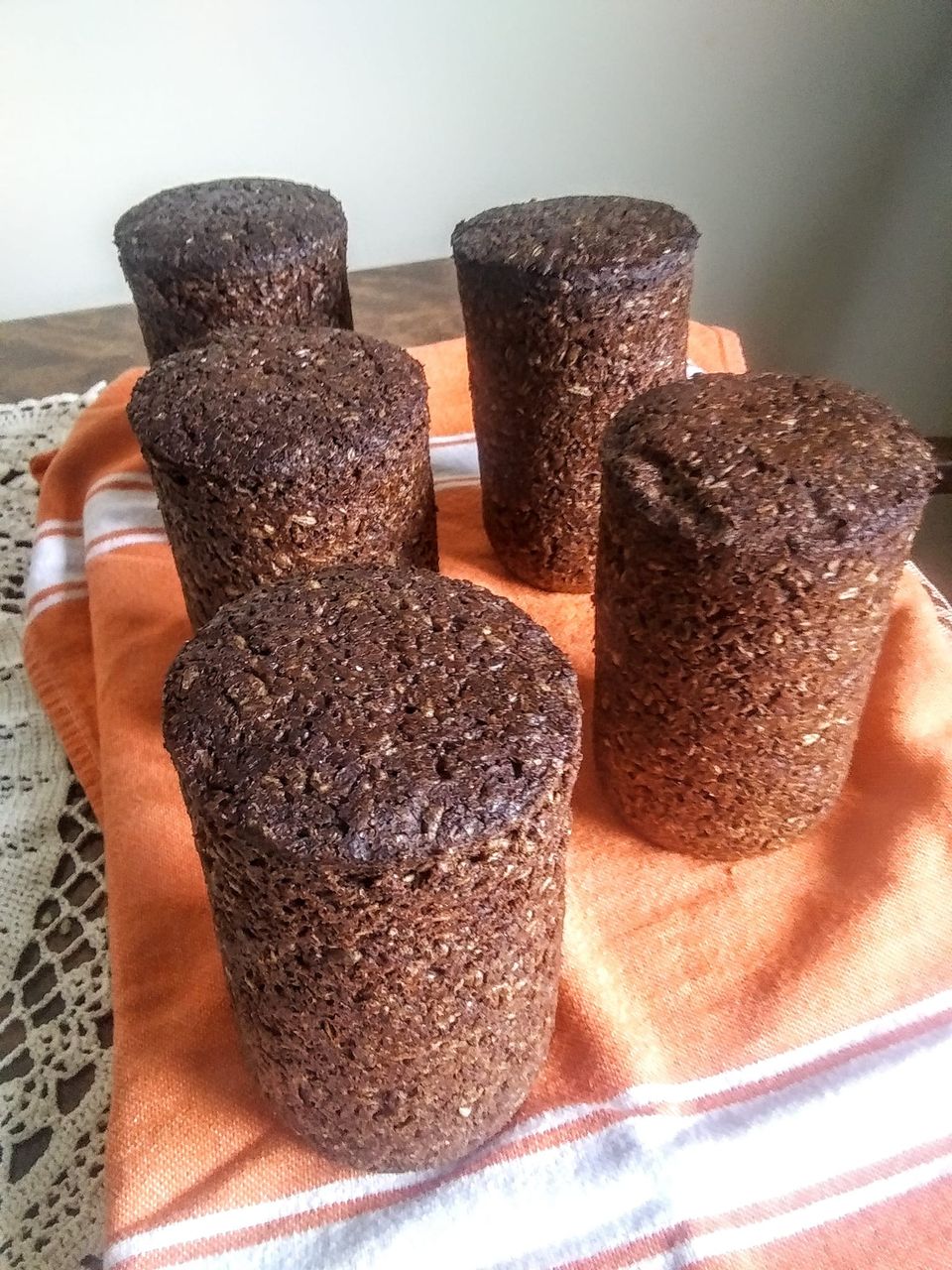Lütz Geissler's Hütten-Pumpernickel. Story is too long, suffice it to say I had a hell of a time maintaining the falling temp of 175F for several reasons. So, deciding overnight it was too risky to leave the oven so low (lowest I could get was 190F), I conceded a fail and shut the oven off - skeptically thinking, maybe it will just dry out and at least I'll have something. Next morning, I thought why not, and I turned the oven back on to its lowest and let the pumpernickel steam for a few more hours. This is the result:


Comically, the flavor is really good. Texturally, the crumb isn't gummy but slightly tacky, I imagine the difficulties with running the target temp over so many hours. I think Lütz's formula, like everything I've tried by him to date, is worth doing again, probably many times.
You have a good-looking loaf. From the pictures, it seems to have emerged without an armored crust; yet another plus.
While I have done an overnight bake, I wasn’t comfortable with the idea of having the oven on that long. Yes the temperature is very low but there's no one awake to keep an eye on things.
What I have considered, but haven’t yet tried, is using a countertop roaster. We have one, compliments of my in-laws years ago. This particular one came equipped with loaf pans that can be suspended from a frame that sits on the upper rim of the roaster. The idea, I think, is that hot water can be placed in the bottom of the roaster so that it can be used like a steam table for keeping prepared foods hot. Maybe, just maybe, that setup (with the lid on) could also be used for steaming pumpernickel overnight. Something for me to look into further, since I don’t know whether the roaster might have an automatic shut-off circuit that limits the amount of time it can be left on.
Paul
You might want to check out Lütz's Pumpernickelstange (here). He cooks the dough in a boiling water bath for 16–20 hours.
YES! On it!
I made the Pumpernickelstange last week. 20 hours in a sous-vide contraption. Came out great. After they cooled, I wrapped the Stange tightly in plastic wrap and put them in an airtight bread box. I munched on one of the Stange for about 4 days and then it started to get moldy. I’m trying to figure out the exact cause of that. They were moist to begin with and it has been very humid here. Maybe that’s the reason for the mold. Any ideas? Thanks.
Thanks Paul.
That's fantastic - I'd love to hear how your experiments go. Do you mind sharing the model?
I'd love something like a rice cooker, which can turn off and on per the dictates of the Inkbird controller without having to go through the need for manual resetting after every shutoff. I'd probably have to go with a cylinder shape loaf.
Years ago, trying to be clever beyond my pay grade, I bought an Avantco countertop food warmer to use as a cheese vat (among other cheeses, I made tommes, semi-soft, pressed, uncooked cheeses), and the volume was perfect for my 4 gallons of raw milk. I took the controller guts out and replaced them with a PID controller. Seems anything with just that wrap-around band heating mechanism should work.
We'll be back home next weekend and I can check the model number then.
One question that probably will probably require some experimentation to settle is whether the roaster can retain enough of the steam emitted by the bread, or if a pan of water will be needed for optimum humidification.
Paul
I agree Paul(s) 😉, I wouldn’t be comfortable leaving an oven on while we were asleep. I think you did really well given the oven temperature issue and the fact that you turned the oven off and later back on again. It does look like a tasty bread.
Benny
Thanks a lot Benny. It's got me geeked to really work on this. The intensity of flavors is pretty remarkable to me in that there's not much there but rye, and time, with the transformatve power of caramelization and maillard reactions. Haven't done a bread like this to date and I'm really grateful to Lutz for the recipe.
That's another fine output from your rye oven!
What we need for these long bakes are vintage Chambers stoves (here) like my mom had. They had thick insulation that allowed for cooking by retained heat. I remember my mom could put a pot roast in the oven on Sunday morning at ≈500 °F for a short period (probably less than 30 min), turn the oven off, and then it would be ready for Sunday (late) afternoon dinner. It probably could do a good job of mimicking a cooling wood-fire oven.
Thanks for the nice comment and the link, alcophile. That is fascinating. Makes me think of the French village tradition with their bakers' ovens - families' stews and so forth placed in to braise after the last firing, with the door shut, coming back the next morning to take their meals home. Very cool - love this stuff.
I baked during the day for 14 hours, (Put a baking stone in to create some thermal mass,) and then turned the oven off left the bread in and went to sleep. It worked really well. The oven was still warm in the morning - probably around 10 hours later... Mine is not quite as dark as yours but close, and quite delicious.
Is this the recipe? Where did you get all the schrot?
Thanks jl. Yep, that's the recipe, and I had to parse out "schrot" from what I had on hand, and what's otherwise available. I bought up a lot of BA "pumpernickel" flour some time ago and need to move through it. Even though it's milled and not chopped, it seems to me to be a hybrid between what I've seen as "fein" and "mittel" coarseness. So it served as both in my make of Lutz's recipe. The "groß scrot" I used was actually "rye chops" I confirmed with both BA and Ardent Mills, which is who provides the chops to BA, as true chops and not merely cracked rye.
Once I burn through my stores of pumpernickel, chops from BA and "cracked rye" from Janie's, I intend to try to emulate coarseness in my home milling, acknowledging it's merely meal and not chops I'm making.
Some pics. German sources first.
This one is considered "fein" by the company:
Finally, from a German Baking forum, three grades:
Here's what I have. BA Pumpernickel:
BA Rye Chops:
And side-by-side:
So won't be true schrot, but I think I can get at least something resembling the three grades of coarseness. The difficulty will be keeping a consistent milling, since my mill doesn't have gap steps like "1, 2, 3...".
I try to aim for a few kernels slipping through unscathed. The rest are broken up; some cracked and some in smaller particles. There's even some flour in the milled stream.
So far, I’ve used the milled rye without any screening or sifting and it has worked well for rugbrot and pumpernickel style breads. Most recipes call for a combination of cracked/chopped grains and some finer meal/flour. I mill enough to have the total quantity of rye that the recipe calls for.
Is this approach by-the-book? Not really. It does let me produce rye breads that I like, though, while eliminating some of the steps and mess that would be required to maintain procedural purity. YMMV.
Paul
So Paul you can get this variety with a mill gap allowing some through whole? I'll have to try it. Thanks.
I have KoMo stone mill, which allows quite a wide range of fine to coarse settings. Rye kernels are rather slender, compared to wheat or barley, so I sometimes have to adjust on the fly so that only the skinniest kernels slip through. Just eyeballing it, I’d say less than 5% are still whole after milling.
This helps minimize the amount of flour in the output. Rye is soft enough that it tends to go to powder fairly easily. Since I want maximize the meal fraction, I’m willing to tolerate a few coarser chunks.
Paul
But authentic and tasty. I put mine in mason jars and baked in a Turkey roaster with a few inches of water
Those are so cool! Which size mason jar - mine are all narrowing at the top (quart and 1/2 gallons)? I'd love to try it - also opens up ideas.
Hi these are Bell brand jars typically used in canning these were 16oz/480ml straight sided wide mouth. These are not tempered glass but using a water bath makes it ok for oven..
Awesome. Thanks Donna.
I agree with Paul, those are really cool and such a great idea.
Benny